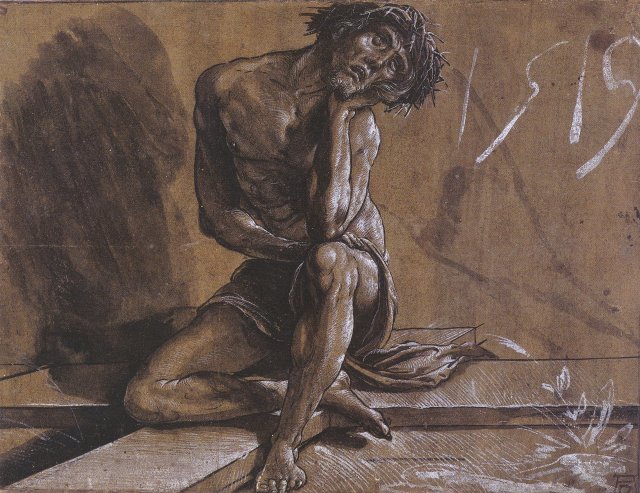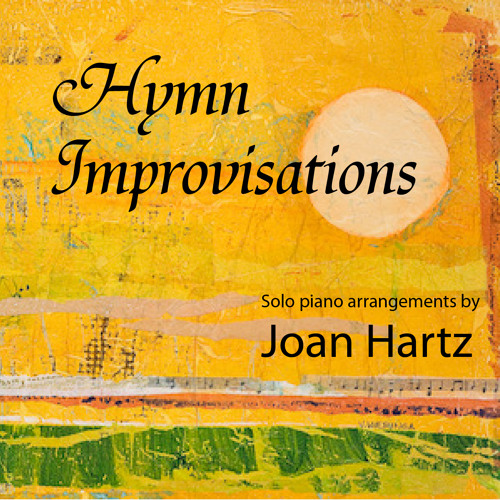Before Rodin’s The Thinker, there was the Pensive Christ.

Pensive Christ figurines by three contemporary Lithuanian artists: (from left to right) Tomas Ivanauskas (2001), Algirdas Juškevičius (2000), Svajūnas Motijoška (2001).
Dating back to the late fourteenth century, this iconographic type shows Jesus sitting on a stone, bent over, supporting his head with one hand while resting the other on his knee. Sometimes he is crowned with thorns, sometimes not, but either way he bears an expression of exhaustion and grief and is thus associated with the Passion.
Although the image first appeared in northern Germany, it is now most commonly associated with Lithuania, where the figure is called Rūpintojėlis (pronounced roo-pinto-YAY-lis): “the One Who Worries,” or “the Brooding One.” (“The Pensive Christ” is not a strict translation, but that is the name that has gained favor in the English-speaking world; “Christ in Distress” is another.) As Christianity spread throughout Lithuania in the sixteenth and seventeenth centuries, so did images of Rūpintojėlis, as the wandering woodcarvers (dievdirbiai) of native folk culture carved him into hollowed-out tree trunks wherever they went. Today he is found not only at crossroads and in forests but in churches, homes, cemeteries, and shops.
Lithuanians relate the figure to their own passion as a people, especially since having had endured persecution under the Soviet regime, including mass deportations to Siberian labor camps and other remote parts of the Soviet Union in the 1940s and ’50s. About 60 percent of the roughly 130,000 Lithuanian deportees either died in the camps or were never able to return to their homeland—a tragedy still mourned by Lithuanians each year on June 14, the date of the first major deportation (in 1941), which they call the “Day of Sorrow.” Others were executed as political prisoners.
For these victims of repression, the Pensive Christ represents a God who identifies with the suffering of humanity. Perhaps he contemplates not only his own unjust treatment and death but also the countless injustices waged against others throughout time. And he weeps.
Here is a roundup of Pensive Christs from Lithuania. To view more, visit www.tradicija.lt, which documents thirty-eight unique examples.
See also the series of acrylic paintings of the Pensive Christ by Dave Matke, an outsider artist of Lithuanian descent, and the article “Understanding the Image of Christ in Distress in Lithuanian Folk Culture: The Conceptions of Passion, Sin and Prefiguration of Prophet Jeremiah” by Gabija Surdokaitė-Vitienė (the English is shoddy but understandable).
Here are a few images of the Pensive Christ originating outside Lithuania, in . . .
> Poland (where the tradition is also strong),

Pensive Christ, early 16th century. Polychrome and gold on wood. Muzeum Diecezjalne w Płocku (Diocesan Museum in Plock), Poland.
> Germany,

Hans Holbien the Younger (German, ca. 1497-1553), Christ at Rest, 1515. Pen and ink and brush, washes, white heightening, on ochre prepared paper, 15.8 × 20.7 cm. Berlin State Museums, Berlin.
> the Netherlands,

Christ on the Cold Stone, Dutch, 1500-20. Limestone, 98 x 49.5 x 48.5 cm. Church of Holy Matthew, Azewijn, the Netherlands.
> and Puerto Rico.












Pingback: “The One who Worries…” – CREDO
😿😔😿😔😿
Wonderful concept.
I saw similar carvings in Poland. It was described to me in English as “worried Jesus.”
Is there a place to order one of those first three carvings?